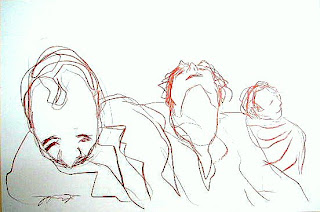Wednesday, July 25, 2007
FAVELA, PROCEDURE

Printed with a typographic press in Torben Bo Halbirk's Studio, Paris, France, 2002

Printed with a typographic press in Torben Bo Halbirk's Studio, Paris, France, 2002
The braziliam word 'Favela' means a shanty-town. As the people who lives in Favelas do, I did with my woodcuts: I've found some pieces of wood on the streets to build my matrix which, after printed, was desconstruct it to give birth to another one, so, in this way, I've printed several houses to form a entire Favela.
Saturday, July 21, 2007
STEALING SHADOWS...

Performance art can be any situation that involves four basic elements: time, space, the performer's body and a relationship between performer and audience.

Performance art can be any situation that involves four basic elements: time, space, the performer's body and a relationship between performer and audience.
“Performance has been a way of appealing directly to a large public, as well as shocking audiences into reassessing their own notions of art and its relation to culture. Conversely, public interest in the medium, especially in the 1980s, stems from an apparent desire of that public to gain access to the art world, to be a spectator of its ritual and its distinct community, and to be surprised by the unexpected, always unorthodox presentations that the artists devise. The work may be presented solo or with a group, with lighting, music or visuals made by the performance artist him or herself, or in collaboration, and performed in places ranging from an art gallery or museum to an “alternative space”, a theatre, café, bar or street corner. Unlike theatre, the performer is the artist, seldom a character like an actor, and the content rarely follows a traditional plot or narrative. The performance might be a series of intimate gestures or large-scale visual theatre, lasting from a few minutes to many hours; it might be performed only once or repeated several times, with or without a prepared script, spontaneously improvised, or rehearsed over many months.”
(Roselee Goldberg states in Performance Art: From Futurism to the Present)
Sunday, July 15, 2007
V I S - À - V I S

20 x 500 cm instalation: varnish on book pages, under plexiglass - Paris, France - 2003
I like to make Installation art, because I have the opportunity of use some sculptural materials or other media ( materials used in contemporary insallation art range from everyday and natural materials to new media) to modify the way people experience a particular space (installation art is not necessarily confined to gallery spaces and can be any material intervention in everyday public or private spaces - some installations are site-specific in that they are designed to only exist in the space for which they were created).

20 x 500 cm instalation: varnish on book pages, under plexiglass - Paris, France - 2003
I like to make Installation art, because I have the opportunity of use some sculptural materials or other media ( materials used in contemporary insallation art range from everyday and natural materials to new media) to modify the way people experience a particular space (installation art is not necessarily confined to gallery spaces and can be any material intervention in everyday public or private spaces - some installations are site-specific in that they are designed to only exist in the space for which they were created).
Wednesday, July 04, 2007
Sunday, July 01, 2007
ANOTHER PAPER IN THE WALL
Performance + collage
"In the beginning was the black wall, and the wall was wider, and the artist had to scale the scaffold in front of the wall. With him was the waste papers and this papers was the light that formed a large face of men. “The Light shines in the darkness and the darkness did not overcome it”.
600 x 900 cm ~ gluing of waste paper on the wall ~ 2005
Subscribe to:
Comments (Atom)



























